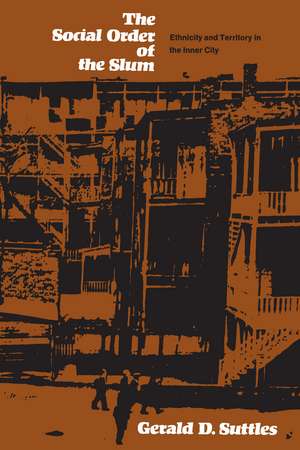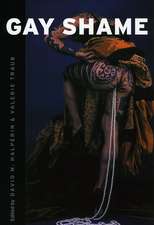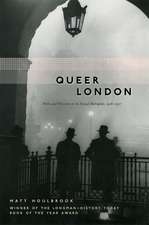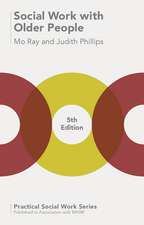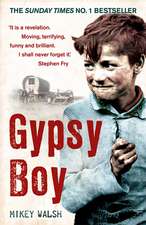The Social Order of the Slum: Ethnicity and Territory in the Inner City: Studies of Urban Society
Autor Gerald D. Suttlesen Limba Engleză Paperback – 31 iul 1970
While he did the research for this book, Gerald Suttles lived for almost three years in the high-delinquency area around Hull House on Chicago's New West Side. He came to know it intimately and was welcomed by its residents, who are Italian, Mexican, Puerto Rican, and Negro. Suttles contends that the residents of a slum neighborhood have a set of standards for behavior that take precedence over the more widely held "moral standards" of "straight" society. These standards arise out of the specific experience of each locality, are peculiar to it, and largely determine how the neighborhood people act. One of the tasks of urban sociology, according to Suttles, is to explore why and how slum communities provide their inhabitants with these local norms. The Social Order of the Slum is the record of such an exploration, and it defines theoretical principles and concepts that will aid in subsequent research.
Preț: 258.91 lei
Nou
Puncte Express: 388
Preț estimativ în valută:
49.56€ • 53.85$ • 41.66£
49.56€ • 53.85$ • 41.66£
Carte tipărită la comandă
Livrare economică 21 aprilie-05 mai
Preluare comenzi: 021 569.72.76
Specificații
ISBN-13: 9780226781921
ISBN-10: 0226781925
Pagini: 266
Dimensiuni: 152 x 229 x 18 mm
Greutate: 0.36 kg
Ediția:Revised
Editura: University of Chicago Press
Colecția University of Chicago Press
Seria Studies of Urban Society
ISBN-10: 0226781925
Pagini: 266
Dimensiuni: 152 x 229 x 18 mm
Greutate: 0.36 kg
Ediția:Revised
Editura: University of Chicago Press
Colecția University of Chicago Press
Seria Studies of Urban Society
Cuprins
Figures
Maps
Tables
Part 1. Territoriality and Ordered Segmentation
1. Slum Neighborhood
The Provincial Morality of Slum Neighborhoods
Slum Neighborhoods as Culture-Building Worlds
The Addams Area
2. The Ecological Basis of Ordered Segmentation
Geographic Setting
History and Background
Conditions During the Present Study: 1962-65
The Public View
The Local View
The Order of Segmentation
The Ecological Basis for the Corporate Unity of the Addams Area
Part 2. Institutions and Patterns of Communication
3. Institutional Arrangements
Religion
Commercial Engines
Recreation
Education
4. Communicative Devices
Language
Gestures
Clothing, Grooming, and Personal Display
5. Communical Channels
Street Life
Business Establishment Groups
Institutionalized Segregation of Sex and Age Groups
The Congestion of Domestic Life
Historical and Universal Social Environments
Part 3. Ethnic Solidarity
6. The Park and the Italians
The Spirit of Omerta
The Ethics of "Natural Man"
Reformulations of Cultural Traditions
Named Groups
Cross-Sex Relations
The Barracudas and the Park
The Incognitos and the Pica People
The Basis of Adult Power
7. The Projects and the Negroes
The Heritage of Political Arrangements
Style of Life
Mixed Blessings
Named Groups
8. The Puerto Ricans and the Mexicans
Polk and Laflin: The Mexicans
Harrison Street: The Puerto Ricans
Part 4. The Boys' World
9. The Composition of Local Street Corner Groups
Sex
Size
Age
Ethnicity
Residence
Conclusion
10. Primary Groups and Personal Identities
Norms and Uniformity of Behavior
Personal Identities
Pattern of Cohesion
11. The Boys' World and the Wider Society
Rumors and Rumbles: Tragetore
Encounters with the Police
Victims and Complainants
Changes Through Time
Part 5. The Meaning of Morality
12. Practicality and Morality
Provincialism
Ordered Segmentation
Conflict and Order
The Extension of Face-to-Face Relations
Reality and Morality
Sources of Instability and Change
Bibliography
Index
Maps
Tables
Part 1. Territoriality and Ordered Segmentation
1. Slum Neighborhood
The Provincial Morality of Slum Neighborhoods
Slum Neighborhoods as Culture-Building Worlds
The Addams Area
2. The Ecological Basis of Ordered Segmentation
Geographic Setting
History and Background
Conditions During the Present Study: 1962-65
The Public View
The Local View
The Order of Segmentation
The Ecological Basis for the Corporate Unity of the Addams Area
Part 2. Institutions and Patterns of Communication
3. Institutional Arrangements
Religion
Commercial Engines
Recreation
Education
4. Communicative Devices
Language
Gestures
Clothing, Grooming, and Personal Display
5. Communical Channels
Street Life
Business Establishment Groups
Institutionalized Segregation of Sex and Age Groups
The Congestion of Domestic Life
Historical and Universal Social Environments
Part 3. Ethnic Solidarity
6. The Park and the Italians
The Spirit of Omerta
The Ethics of "Natural Man"
Reformulations of Cultural Traditions
Named Groups
Cross-Sex Relations
The Barracudas and the Park
The Incognitos and the Pica People
The Basis of Adult Power
7. The Projects and the Negroes
The Heritage of Political Arrangements
Style of Life
Mixed Blessings
Named Groups
8. The Puerto Ricans and the Mexicans
Polk and Laflin: The Mexicans
Harrison Street: The Puerto Ricans
Part 4. The Boys' World
9. The Composition of Local Street Corner Groups
Sex
Size
Age
Ethnicity
Residence
Conclusion
10. Primary Groups and Personal Identities
Norms and Uniformity of Behavior
Personal Identities
Pattern of Cohesion
11. The Boys' World and the Wider Society
Rumors and Rumbles: Tragetore
Encounters with the Police
Victims and Complainants
Changes Through Time
Part 5. The Meaning of Morality
12. Practicality and Morality
Provincialism
Ordered Segmentation
Conflict and Order
The Extension of Face-to-Face Relations
Reality and Morality
Sources of Instability and Change
Bibliography
Index
